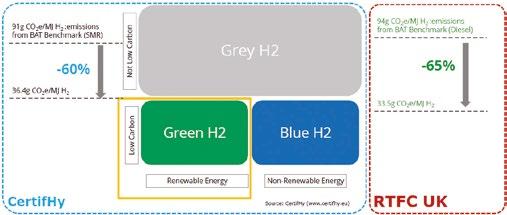
4 minute read
Hydrogen for the energy transition
For more information, please contact Dr Martin Lawrence, CEng, MIMechE, Combustion Development Specialist at Air Products PLC. Mobile: +44 (0) 7887624893. Email: lawrenm1@airproducts.com. Or visit: https://www.airproducts.com/ applications/melting-non-ferrous
Climate change is being accelerated by greenhouse gas emissions. The UK is looking to become leaders in the Energy Transition from fossil fuels to using sustainable energy sources. Following the Climate Change Act, published in 2008 and a series of Carbon Budgets, the UK government are setting into law the world’s most ambitious climate change target to map out how to cut emissions to net-zero by 2050. There are a number of potential routes towards net-zero carbon emissions, including electrification, biofuels, gasification, carbon capture, and hydrogen.
Some industrial processes are suitable for electrification, whereby fossil fuel powered furnaces and boilers can be replaced with equipment powered by green electricity. However, hard-to-abate industries and processes may have to switch to low carbon fuels, such as hydrogen. Carbon capture may be an alternative solution to fuel switching if the carbon dioxide (CO2) can be stored or used effectively and economically. Hydrogen has been identified as one of the leading candidates for low carbon fuel switching to enable the transition towards net-zero carbon emissions in transport and heavy industry. This is due to its properties and its potential to become a clean alternative to fossil fuels, such as natural gas, oil, and coal. A transition from fossil fuels to low carbon hydrogen is likely to become the best route to net-zero for the aluminium industry, where electrification and carbon capture may not be possible or economical.
Hydrogen production Hydrogen is the most abundant element in the universe, and it is used for a number of industrial processes, including petroleum refining, fertiliser production, and metal treatment. However, on Earth, it only occurs naturally as part of compounds, such as water and organic molecules. Therefore, in order to produce pure hydrogen, the hydrogen must be extracted from these compounds and this needs to be done in an efficient and environmentally friendly way for the hydrogen to be considered low carbon. Most industrial hydrogen is considered grey hydrogen as it is produced from the steam reformation of methane and its production has similar CO2 emissions to the combustion of coal. Zero and low-carbon hydrogen can be produced from electrolysis using renewable energy (green hydrogen) or by applying carbon capture to steam methane reforming plants to reduce the amount of CO2 emitted into the atmosphere (blue hydrogen). There are a number of certification and “guarantee of origin” schemes for low-carbon and/or renewable hydrogen. These include or derive from CertifHy, TÜV SÜD, and the Renewable Transport Fuel Obligation and define varying thresholds for hydrogen to be considered low carbon and/or renewable. Carbon intensity thresholds are generally calculated as a percentage of CO2 emissions saving based on a fossil fuel equivalent benchmark, type and age of the hydrogen production facility, and use of hydrogen. The threshold is typically between 33 - 38 gCO2e/MJLHV of hydrogen produced by steam reformation of methane (blue hydrogen) and can be below 30 gCO2e/MJLHV for electrolysis (green hydrogen). It is expected that the thresholds will become more stringent as we approach key net-zero milestones. Figure 1 shows a comparison of different types of hydrogen, with respect to CO2 emissions and shows examples of best available technology (BAT) benchmarks, with low carbon thresholds from CertifHy and RTFC UK.
Hydrogen supply chain Hydrogen is an industrial gas that has been supplied to industries around the world for many years and as such there are several solutions when considering the supply of hydrogen. Air Products offers liquid hydrogen and compressed hydrogen gas in a variety of purities and various modes of supply around the world, with an extensive network of pipelines, hydrogen manufacturing plants and transfill facilities. Hydrogen can be generated at a large plant and supplied via pipeline locally to the end use point. Large plants can be designed to include a liquefier, which can produce liquid hydrogen for remote supply. This can be decanted into transportable tankers and delivered by truck or train and then used to fill cryogenic storage tanks, located on the site of the end user. It is also possible to provide high pressure gaseous hydrogen via tube trailer to a remote location in a similar manner. Figure 2 (overleaf) shows a photograph of a liquid hydrogen tanker for hydrogen deliveries. Gaseous or liquid bulk deliveries are great for supplying processes that are not local to a large plant and can be suitable for varied hydrogen usage. Hydrogen can also be transported and stored safely as ammonia, which can be liquified under milder conditions and therefore it can be stored in inexpensive pressure vessels, rather than cryogenic containers. Furthermore, liquid ammonia contains about 1.7 times more hydrogen by weight than liquid hydrogen; liquid hydrogen contains 71 kg-H2/m3 and liquid ammonia contains 120 kg-H2/m3 . On-site generation is another option for remote processes that require a consistent supply of hydrogen, whereby


